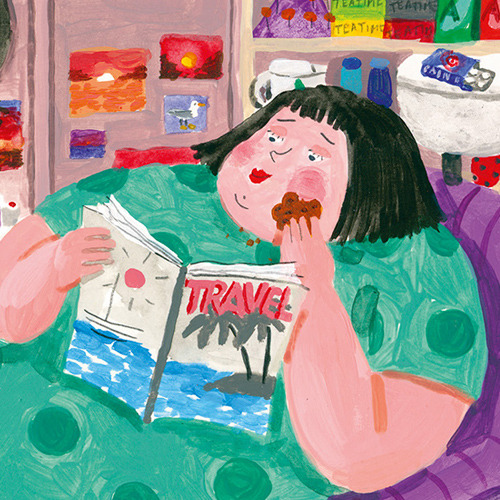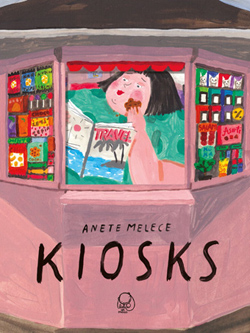< Back to posts
Anete Melece
Latvia

Anete Melece studied Visual Communication at the Art Academy of Latvia and Animation at Lucerne University of Applied Sciences and Arts. Her animated short ‘The Kiosk’ has been shown in film festivals around the world and received many awards. Anete lives and works in Zürich as an animator and illustrator of comics and children’s books.
In this post, Anete talks about the creation of ‘The Kiosk’, a wonderful picturebook based on her award-winning animated short. Originally published in Latvian by Liels un mazs, the book is set to be published in many more languages, including Swedish, German and Korean.
Anete: Usually films are made out of books, but in this case it was the other way around. Six years ago, I created an animated short called ‘The Kiosk’ (Virage Film, 2013), and this year a picture book version of the same story was released by Latvian publisher Liels un Mazs.
The idea of a lady who is literally stuck at her workplace came to me an even longer time ago. It was a time in my life when I felt like a potato. I had a decent job in an office, earned more money than I ever had before, and everything was kind of okay, except that I had a feeling that I was in the wrong place and that I had stopped growing. This idea didn’t leave me alone and I had to figure out a way – how to make it. I finally left the job and applied for a Masters at the Lucerne University of Applied Sciences and Arts – a program called Animage (Animation and Illustration).
Actually, I drew a comic about all this. You can read it in full on my website, but here’s a few pages. It’s called ‘Busy Freelancer at Work’.
During my studies in Lucerne, I worked on the development of the story for ‘The Kiosk’. First, I thought a lot about the character: Why is she stuck there and what does she actually want? To find a romantic love or maybe to change profession and become an opera singer? Finally, I came to a simple conclusion: As she is literary stuck, then all she dreams about is freedom.
Sometimes people ask me why she didn’t lose weight to get out? Because it would be very boring and the story is not about being fat; it’s about being stuck. You can move on and start a journey to your happy place exactly as you are. Right now.
To collect some ideas for the side characters and Olga’s life in the kiosk, I also did some research. I did interviews with a few kiosk sellers and even spent a day in one. Well, that kiosk was not as small as Olga’s kiosk; it was more like a little shop, where I was sitting in a corner and observing situations and sketching the people that came there.
I worked on the animation in Switzerland, where I am still living. However, the action in the film and even more in the book happens in Riga, Latvia, where I am from.
The shape of the kiosk was inspired by a real art deco style kiosk in Riga, which lately has been mostly standing unused.
After three years, the seven minute animation was finally finished. I was travelling with it to film festivals all around the world, and I realised that not only the beginning of the story was about me, but the end of it too. Just like Olga, I was travelling around with ‘The Kiosk’ and I was totally happy. But most importantly, I had found the freedom to do the things that I love.
I had never really thought about making a book of ‘The Kiosk’. Not before Roger Thorp from Thames & Hudson and Alīse Nigale from Liels un Mazs told me that it would be an idea worth considering. The considering took another three years; I was always busy doing other projects – like making a baby and becoming a mother. Meanwhile, I think I just needed some more time to find the motivation to work on a story that ‘I had already told’ again.
How to transform a film into a book? The easiest way would be to make the key screenshots and explain the missing parts with some text. Yes, if you want it to look like a lazy copy of the film, only without sound and movement.
For a while, I forgot about the animation and focused on the story itself…
I didn’t even use the existing material, like the characters and backgrounds that had already been painted for the digital cut-out technique used for the animation. I knew that if I needed a new background, it would be very hard to paint exactly like I had done six years ago, and I didn’t want it to have that cut-out look.
In the end I painted everything new, using the film as reference for the character and background design. And to slightly compensate for the lack of voices, music and movement, I tried to use the advantages of the book format – readers have more time to look at each ‘frame’ – so there are more side characters and details. A kiosk is a perfect subject (or object) for that. I also added a couple of side stories for the background characters.
Perhaps some hardcore fans of the animated version (I don’t know if they exist though) could be disappointed to see that the picture book is so different. I would like to invite people not to compare, but to simply enjoy them each in their own way.
During this whole journey, I was never alone. At the beginning, while working on the story, I got a lot of support from my university mentors, especially Ted Sieger, Jochen Ehmann and Paolo Friz. It would be impossible to finish the animation without my producer Saskia von Virág and animator Stefan Holaus. I thank the whole team of Liels un Mazs for being so supportive. And also thanks to Hans ten Doornkaat for his advice while working on the book. And last but not least, thanks to my family for their love and inspiration.
Illustrations © Anete Melece. Post edited by dPICTUS.
Kiosks / The Kiosk
Anete Melece
Liels un mazs, Latvia, 2019
For years now, the kiosk has been Olga’s home simply because her sweet tooth and monotonous life have made her larger than the exit. To distract herself, she reads travel magazines and dreams of being far away. An absurd occurrence sets her off on her journey.
Based on Melece’s animated short which has received many awards worldwide.
- Latvian: Liels un mazs
- German: Atlantis Verlag (2020)
- Swedish: Lilla Piratförlaget (2020)
- Korean: Mirae M&B (2020)
- Other languages are in negotiation

























